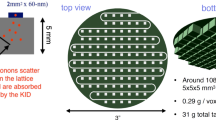Abstract
The WA97 experiment is a part of the CERN heavy-ion program. The experiment aims to measure enhanced strangeness production as a signal of the phase transition from a Quark-Gluon Plasma. The first run for the experiment was in the autumn 1994, when CERN accelerated lead-ions in the SPS ring for the first time. The WA97 experiment have used silicon microstrip and pixel detectors with technology which have never been used before. It is shown that even the triply strange Ω can be reliably measured in the experiment.
Similar content being viewed by others
References
Rafelski J. and Müller B.: Phys. Rev. Lett. 48 (1982) 1066.
Andersen E. et al.: Nucl. Phys. A 610 (1996) 165c.
Heijne E.H.M. et al.: Nucl. Instr. Meth. A 349 (1994) 138.
Author information
Authors and Affiliations
Rights and permissions
About this article
Cite this article
Knudsen, B.T. Presentation of the WA97 experiment at CERN. Czechoslovak Journal of Physics 47, 925–929 (1997). https://doi.org/10.1023/A:1021200315694
Issue Date:
DOI: https://doi.org/10.1023/A:1021200315694




